-
- This session will be captured on Zoom, if I remember to turn it on, and record it.
- Our page of zooms and the play-by-plays.
- Just keep your eyes open and you'll find cultural references to
material in this course: The
Mysterious Bronze Objects that Have Baffled Archaeologists for
Centuries: The first dodecahedron was discovered nearly 300 years
ago, yet no one is certain just what they were used for.
- You have a new assignment: a reading for next time, and making your own set of Platonic solids.
- We wrapped up Platonic solids, super-symmetric objects in three-dimensions
- We learned how to use Duality and Euler's formula to figure out how many edges each must have, and saw the relationship between the characteristics of Dual solids.
- Dramatic foreshadowing of today's discussion: the duals fit together and form fractals, self-similar "cascades" that can go on forever....
Today we're going to examine fractals in a couple of different contexts, and then talk about how to make a few.
- Other rectangles turn golden: you've seen fractals in
this class already, and hopefully you've heard me
mention them. I mentioned them in the context of the
Fibonacci numbers, and in the context of the Fibonacci
and Golden spirals.
In the latter two cases, you recall that by constructing spirals with squares in certain ways, we ultimately achieve (or tend to) a golden rectangle, which contains a perfect copy of itself (only smaller): the side lengths are in the ratio $\phi$, where \[ \phi=\frac{1+\sqrt{5}}{2} \]
- Now: what kind of rectangle will you get if you repeat the
spiral process with a non-Fibonacci rectangle to start (rather
than a 1x1 square)? For example, you might start with a 3x1
rectangle, and then append the biggest square you can each time.
Turns out, that if you do it over and over and over again, you'll still obtain rectangles that becomes more and more golden!
But that's because we were adding a square each time. Let's try another process....
- The A0
Paper Fractal
"A paper" is something you've no doubt encountered before: it's the long sheets we occasionally use (usually "A4" paper), types of paper far more common in Europe.
"A paper" is constructed so that, if folded in half (do we say the long way or the short way?), you get a sheet which has exactly the same shape -- that is, the ratio of its side lengths is the same as the original sheet.
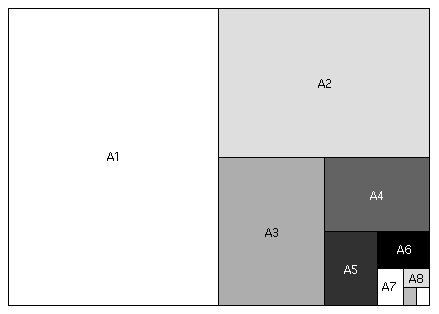
Let's see what the dimensions of A paper must be so that this requirement is fulfilled....
Call the long dimension of the A1 paper above $x$, and the short dimension 1.
- Then the ratio $x:1$ is the same as the ratio $1:\frac{x}{2}$.
- Solve for $x$: \[ \frac{x}{1}=\frac{1}{\frac{x}{2}} \] and we've got another quadratic equation on our hands! Fortunately we recall how to "work our quads" (and this one happens to be particularly easy): \[ x^2=2 \] so $x=\sqrt{2} \approx 1.4142$.
Let's check: here are the "official" paper sizes (in mm):
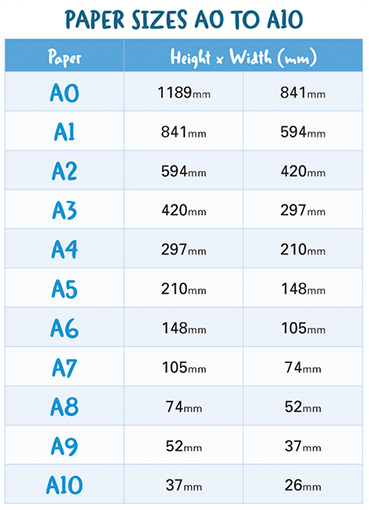
Pick a height, and divide by the width, and what do you get? Approximately 1.4142.... E.g. A1: $841/594 \approx 1.4158$.
- Why not an A0 paper spiral? Let's try that....
This is the spiral, created using non-squares ("A-rectangles") each time:
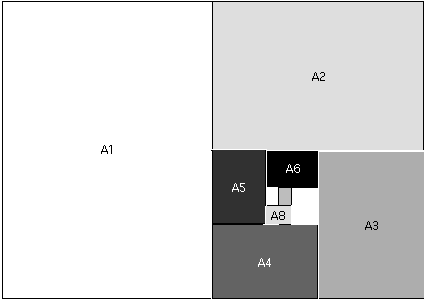
We could go on forever! There's "the world within the world". This is a fractal.
(By the way, the spiral image above has dimensions 424x300 -- the ratio? 1.4133333333333333....)
- Fractals
- The concept of fractals is the most modern mathematics that we
study in this course. We've worked our way up from the Babylonians all
the way to the 21st century.
- Here is our "intuitive" definition of a Fractal:
-
A world within a world! By which I mean that there's a perfect copy of the fractal contained within itself -- and perhaps infinitely many!
For example, in the A0 Fractal, the whole rectangle (A0 paper) contains smaller (but perfect) copies of itself -- A1, A2, A3, .... papers.
This key notion is more formally called "self-similarity": "a self-similar object is exactly or approximately similar to a part of itself (i.e. the whole has the same shape as one or more of the parts)."
- Some other examples you have already seen during our course:
- Dual Platonics: e.g. a tetrahedron within a tetrahedron
within a tetrahedron.... Maybe cooler are the other pairs, where we
alternate solids (hexa then octa, or icosa then dodeca), then
repeat the process:
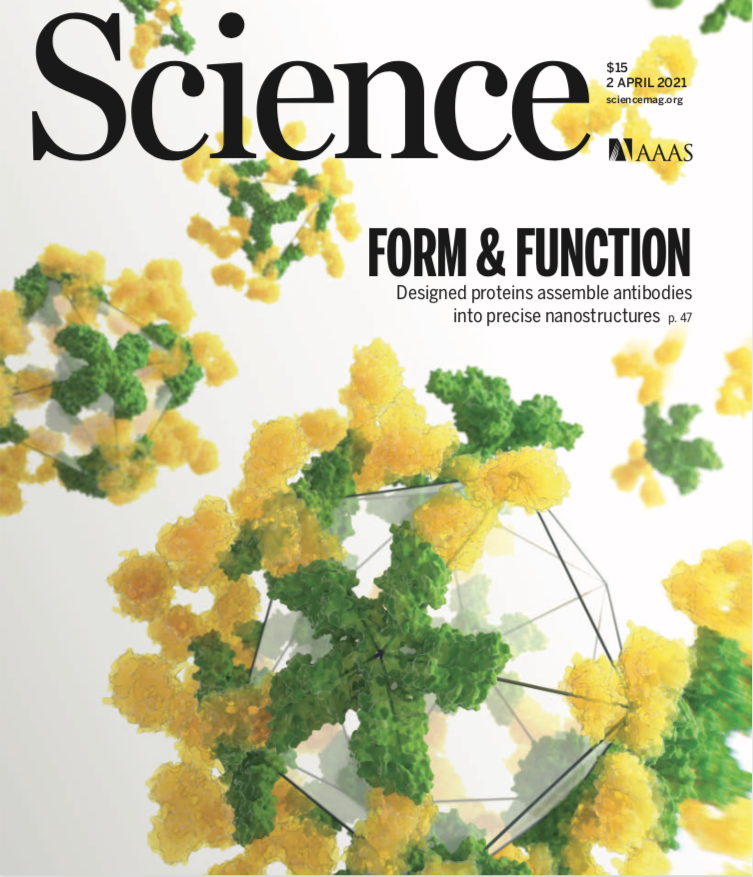
- The tree diagram of the rabbit problem that gave rise to the Fibonacci
numbers:

- I shared my "Flirting with Death Spiral" a couple of weeks
ago:

- Often these arose out of the idea that we carry out a process, then "do it again, do it again"....
- Dual Platonics: e.g. a tetrahedron within a tetrahedron
within a tetrahedron.... Maybe cooler are the other pairs, where we
alternate solids (hexa then octa, or icosa then dodeca), then
repeat the process:
- Here are some examples you might have seen before:
- Here's a suitable mascot for this unit: Bessie the fractal cow:

- World's
Most Famous Fractal discovered/created by the late Benoit
Mandelbrot (Novel Mathematician, Dies at 85: 10/14/2010):
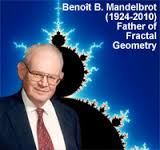
- Here's a suitable mascot for this unit: Bessie the fractal cow:
- So what is a fractal? A
couple of things we'll generally see:
- It's a process or graph that possesses "self-similarity".
- It often possesses a simple and recursive (or iterative)
definition -- that is, we do something, and then we "do
it again!"
- It's a process or graph that possesses "self-similarity".
- Let's check out a beautiful gallery of natural
fractals.
It turns out that nature loves fractals, just like it loves Fibonacci numbers.
I found this image in a recent issue of Science magazine:
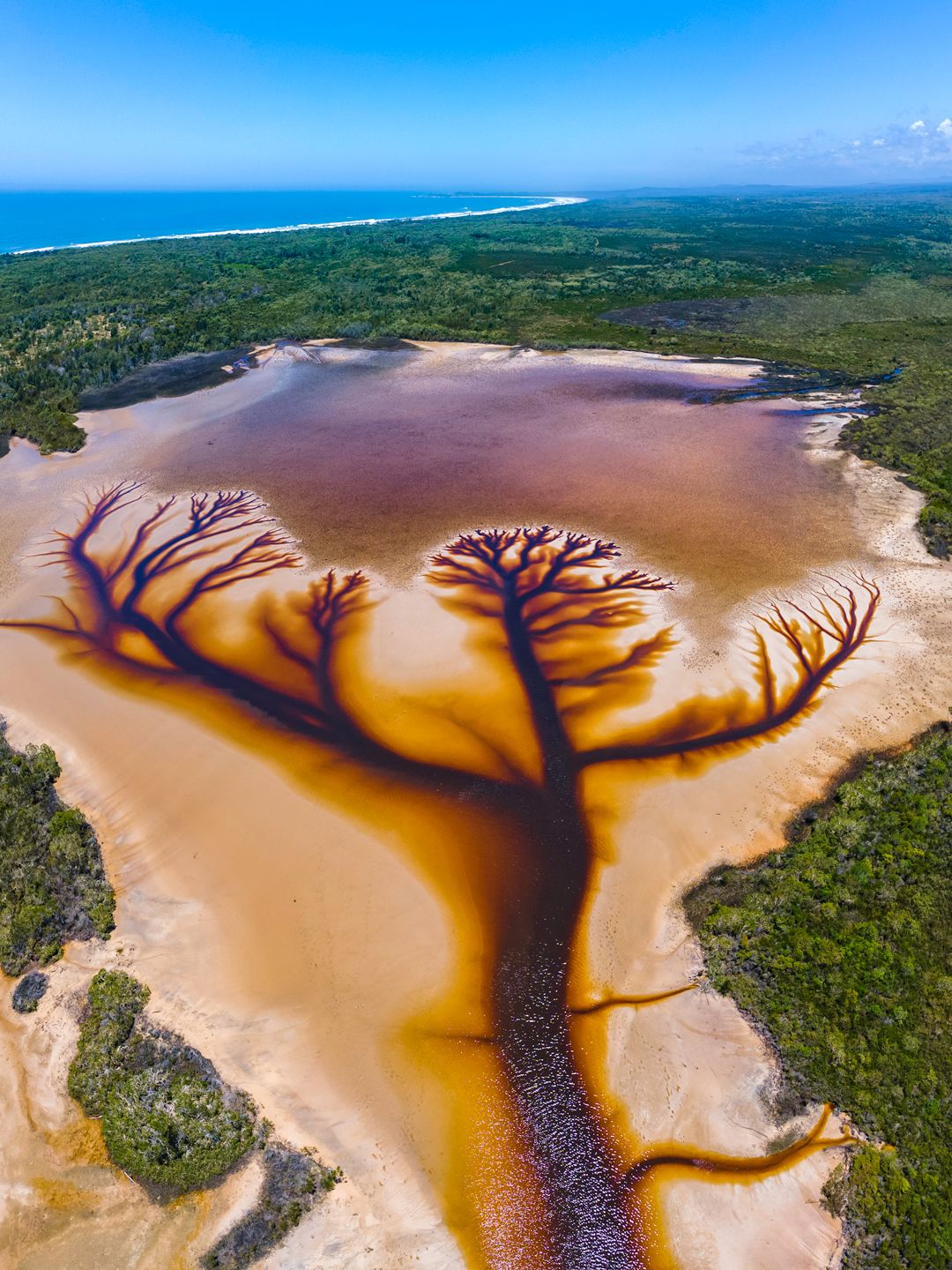
- Building deterministic fractals with sticks
- Consider the famous "Koch" fractal:
- Start with a straight stick.
- Replace the middle third of the stick with a little "tent" -- two third-length sticks.
- Do it again and again!
- This triangular paper is good for that.
This fractal becomes infinitely long, but in a confined space! Very strange.... but this type of strange behavior is typical of fractals.
Let's make a variation of that. Use your graph paper, and a stick along the edge that's 27 units long. Best to use a pencil with a good eraser!
Instead of triangular tents, we'll make square tents.
-
Here
are some more lovely examples
(including the Koch
fractal, but check out the beautiful bushes!).
- The Sierpinski triangle is an area fractal.
- Triangular paper is good for Sierpinski....
- Triangular paper is good for Sierpinski....
- Let's create one by subtraction.
- After we're finished removing all that stuff, how much area is left in the triangle?
- Consider the famous "Koch" fractal:
- Now let's introduce a little bit of randomness: Sierpinski's
triangle again
The Chaos game - generating fractals using random movement!
- Once again, simple rules lead to complex
objects. This time, however, we don't proceed
methodically, but rather haphazardly - and yet we still
produce the complex images.
One of the most interesting fractals arises from what Michael Barnsley has dubbed ``The Chaos Game'' [Barnsley]. The chaos game is played as follows. First pick three points at the vertices of a triangle (any triangle works---right, equilateral, isosceles, whatever). Color one of the vertices red, the second blue, and the third green.
Next, take a die and color two of the faces red, two blue, and two green. Now start with any point in the triangle. This point is the seed for the game. (Actually, the seed can be anywhere in the plane, even miles away from the triangle.) Then roll the die. Depending on what color comes up, move the seed half the distance to the appropriately colored vertex. That is, if red comes up, move the point half the distance to the red vertex. Now erase the original point and begin again, using the result of the previous roll as the seed for the next. That is, roll the die again and move the new point half the distance to the appropriately colored vertex, and then erase the starting point.
From randomness comes order; from simple rules comes complicated objects! Then all hell broke loose.
- Once again, simple rules lead to complex
objects. This time, however, we don't proceed
methodically, but rather haphazardly - and yet we still
produce the complex images.
- The concept of fractals is the most modern mathematics that we
study in this course. We've worked our way up from the Babylonians all
the way to the 21st century.
- Now: what kind of rectangle will you get if you repeat the
spiral process with a non-Fibonacci rectangle to start (rather
than a 1x1 square)? For example, you might start with a 3x1
rectangle, and then append the biggest square you can each time.
- Shodor:
- Snowflake on-line
- Gasket on-line
- The Fractal Microscope (click on the image)
- L-Systems
in PostScript, from which I generated this image:

- I first encountered the L-Systems fractals at britton.disted.camosun.bc.ca/fractals_arcytech/lsystems.html, but that's a dead link. However, I copied the files, and have a local copy here. However, web browsers these days don't seem to like the applet tag in javascript, so this doesn't work anymore in a standard web browser...:(